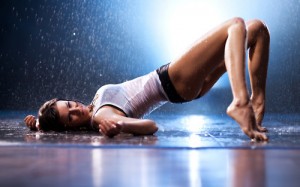I bet you never thought of shoulder-and-feet-elevated hip thrusts as simultaneous knee flexion and hip extension exercises did you? In this video I discuss some of the biomechanics behind shoulder-and-feet elevated hip thrusts. The single leg version is the most difficult hip dominant bodyweight exercise in existence in my opinion, with the prisoner single leg back extension placing second. Though I don’t do strict tempos, if I had to guess I’d say I do these for 2-3 sets of 12 reps with a 1 second concentric phase, 1 second isometric phase, and 2 second eccentric phase and it kills me. As you can see, this is not only a great glute exercise but also a great hamstring exercise.







Great video does this differ a lot from the skorcher
The technique is very similar but the biomechanics differ in subtle ways. I’ll explain this sometime down the road.
You turned me on to the double elevation version a while ago and I really appreciate the brute strength it gives me when I need more speed on a run. If I think about where I want that power to come from I can feel my backside clench like a fist. Taking into account that I am substantially shorter than you my boxes are still closer together during my sets, am I missing any benefit to this exercise by doing it with a more flexed knee? Should I work toward a longer lever leg position for these?
I gotta say seeing a post from you time stamped for Oct 12 when I am sitting on the East Coast still living in Oct 11 is freaky – science from the future! 🙂
No you’re not missing out; you can tinker with the box distance for variety; more distance/less knee flexion equals a bit more hammy, less distance/more knee flexion equals a bit more glute. It is definitely strange being a day ahead of my American peeps!
Cool; I’ve done these previously but on reflection didn’t think about the extra bang for your buck you get with hip extension and knee flexion.
One question for you Bret (apologies if it’s a bit rudimentary)are there any factors beyond glute weakness/low activity and/or soft tissue restrictions that can limit achieving full range hip extension/pelvic neutral in these exercises?
This is definitely not a rudimentary question. What you mentioned would be the primary reasons (lack of end-range glute strength, tight psoas/RF, etc.). Posture could prevent it too as somewhat in severe anterior pelvic tilt couldn’t achieve full hip ext either. With the single leg version, it requires more total body coordination, hip ext strength, and rotary core strength, so many folks skimp on their ROM on this version.
Great; thanks a lot. I’ve been rocking a pretty big anterior tilt through DL’ing with lumbar extension rather than posterior tilt and hip extension at lockout for years, bad idea! On the whole I think mine’s a combination of tight hip flexors, and probably a lack of end-range glute strength. Time to really get stuck in with some end-range work and myofascial work.
Thanks Bret; love your work as a Physiotherapy student, fully intend on throwing some of your work into practice once I roll back around to the Musculoskeletal side of things!
I should’ve added; the above was in regards to increasing loads used, as I tend to find my initial and deload sets I’m able to really get the glutes going, but topsets sometimes I feel a compensation with inadvertent lumbar extension. Just a case of going beyond the glutes capabilities? Thanks!
This is normal. If I go too heavy I do the same. Just as in deadlifts when you go too heavy you flex the spine, when you go too heavy in hip thrusts you extend the spine. Good lifting requires discipline to know the cut-off (I believe 10% degradation is okay).
Do you have a video of the prisoner single leg back extension?
No but I wrote about them here. By holding your arms in the prisoner position you increase the moment of the resistance arm which is essentially akin to holding onto a 20-30 lb dumbbell. Try this for 12 reps with each leg with a strong glute contraction up top and your hammies will be hurting the next day.
http://www.t-nation.com/free_online_article/sports_body_training_performance/12_hamstrings_exercises_for_hardasses
Nice little variation that definitely adds some difficulty to the movement. Maybe add even more difficulty by having the shoulders elevated on a bosu/physio ball, thoughts?
-Greg Spatz, CSCS, CES
Greg, good question. I don’t like the Bosu/Swiss/stability balls for bridging. First, the “flattening out” increases surface area which decreases the lever arm. Second, the stability impedes with glute max muscle force. I’ve written about this in the past but the glute max prefers a stable environment for maximum firing.
If you did it from time to time for coordinative purposes then fine, but if that was the goal I’d prefer to perform a standing single leg exercise which I feel would be better for sensorimotor/proprioceptive transfer. Cheers!
Great explanation, thanks.
mate, you cannot mention the prisoner single leg back extension without showing us how you do it. LOL ;O)
Sorry Bulent, I’ll try to get a video soon. In the meantime check out the hamstring TNation article I linked above which shows a good pic.
I love to focus on my posterior chain! I think most gym-goers focus to much on the anterior chain (chest, abs, biceps)and need to switch this focus to where it’s really needed – the posterior chain (upper back, delts, lower back, glutes, hamstrings, calves). This exercise is perfect for incorporating more posterior chain work into your routine.